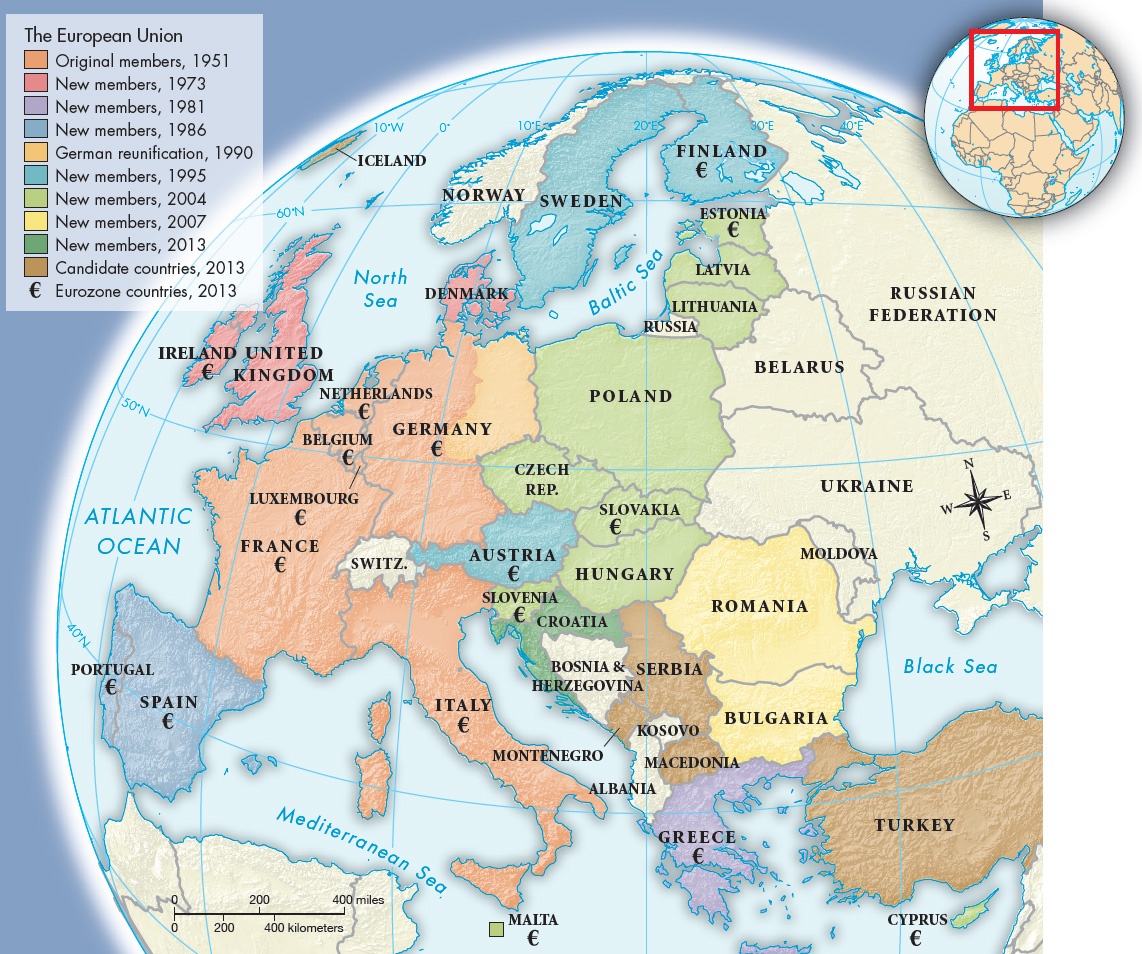A History of Western Society: Printed Page 1016
A History of Western Society, Value Edition: Printed Page 1028
The New European Union
Global economic pressures encouraged the expansion and consolidation of the European Common Market, which in 1993 proudly rechristened itself the European Union (EU) (Map 30.3). The EU worked to add the free movement of European labor, capital, and services to the existing free trade in goods. In addition, member states sought to create a monetary union in which all EU countries would share a single currency. Membership in the monetary union required states to meet strict financial criteria defined in the 1991 Maastricht Treaty, which also set legal standards and anticipated the development of common policies on defense and foreign affairs.
Western European elites and opinion makers generally supported the economic integration embodied in the Maastricht Treaty. They felt that membership requirements, which imposed financial discipline on national governments, would combat Europe’s ongoing economic problems and viewed the establishment of a single European currency as an irreversible historic step toward basic political unity. This unity would allow Europe as a whole to regain its place in world politics and to deal with the United States as an equal.
Support for the Maastricht Treaty was not universal, however. Ordinary people, leftist political parties, and right-wing nationalists expressed considerable opposition to the new rules. Many people resented the EU’s ever-growing bureaucracy in Brussels, which imposed common standards on everything from cheese to day care, supposedly undermining national customs and local traditions. Moreover, increased unity meant yielding still more power to distant “Eurocrats” and political insiders, which limited national sovereignty and democratic control.
Above all, many citizens feared that the European Union was being created at their expense. Joining the monetary union required national governments to meet stringent fiscal standards, impose budget cuts, and contribute to the EU operating budget. The resulting reductions in health care and social benefits hit ordinary citizens and did little to reduce high unemployment. When put to the public for a vote, ratification of the Maastricht Treaty was usually very close. In France, for example, the treaty passed with just 50.1 percent of the vote. Even after the treaty was ratified, battles over budgets, benefits, and high unemployment continued throughout the EU in the 1990s.
Then in 2002, brand-new euros finally replaced the national currencies of all Eurozone countries. (See “Living in the Past: The Euro.”) The establishment of the European monetary union built confidence in member nations and increased their willingness to accept new members. On May 1, 2004, the European Union began admitting its former East Bloc neighbors, and by 2007 the EU was home to 493 million citizens in twenty-seven countries. It included most of the former East Bloc and, with the Baltic republics, three territories of the former Soviet Union.
This rapid expansion underscored the need to reform the EU’s unwieldy governing structure. In June 2004 a special commission presented a new EU constitution that created a president, a foreign minister, and a voting system weighted to reflect the populations of the different states. The proposed constitution moved toward a more centralized federal system, though each state retained veto power over taxation, social policy, foreign affairs, and other sensitive areas. After many contentious referendum campaigns across the continent, the constitution failed to win the unanimous support required to take effect. Ultimately, nationalist fears about losing sovereignty and cultural identity outweighed the perceived benefits of a more unified Europe. Fears that an unwieldy European Union would grow to include Ukraine, Georgia, and Muslim Turkey — countries with cultures and histories that were very different from those of western Europe — were particularly telling.
Though the constitution did not go into effect, the long postwar march toward greater European unity did not stop. In 2007 the rejected constitution was replaced with the Treaty of Lisbon. The new treaty kept many sections of the constitution, but further streamlined the EU bureaucracy and reformed its political structure. When the Treaty of Lisbon went into effect on December 1, 2009, after ratification by all EU states, it capped a remarkable fifty-year effort to unify what had been a deeply divided and war-torn continent.
Yet profound questions about the meaning of European unity and identity remained. Would the European Union expand as promised to include the postcommunist nations of the former Soviet Union, and if so, how could Muslim Turkey’s long-standing application be ignored? How could a union of twenty-five to thirty diverse countries have any real cohesion and common identity? Would the EU remain closely linked with the United States in NATO, or would it develop an independent defense policy? Could members agree on an economic policy to master the stubborn recession that emerged in 2008 and still sapped economic growth five years later, and keep the seventeen-state Eurozone intact (see “The Global Recession and the Viability of the Eurozone”)? The EU struggled to shape institutions and policies to address these complicated issues.

MAPPING THE PAST
ANALYZING THE MAP Trace the expansion of membership from its initial founding as the European Economic Union to today. How would you characterize the most recent members? Whose membership is still pending?
CONNECTIONS Which countries are and are not part of the Eurozone, and what does this suggest about how successful the European Union has been in adopting the euro?